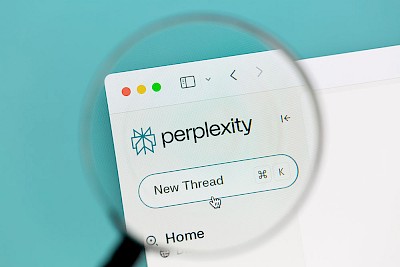An effective approach to evaluating performance is to analyze the impact of training data using traditional tools such as Google Analytics. This makes it possible to understand whether and how the content created by LLM has an impact on your own website and, for example, generates increased traffic - in other words, which sources users have used to become aware of content.

LLMO: How to get the most out of language models
The possibilities around AI-supported text generators such as ChatGPT have triggered a real hype in recent months. Content can be created at the touch of a button - quickly, scalably and in astonishing quality. However, while many companies are already making their first attempts with generative AI, new questions are increasingly arising: How can the performance of such tools be specifically improved? What happens behind the scenes when a text is created? And how can real efficiency be gained from this?
This is where LLMO comes into play - the technical discipline behind the optimization of language models. It ensures that general intelligence is turned into specialized results. But what is behind this term? How does optimization actually work - and why is it becoming increasingly important for companies, agencies and content teams?
In this article, we give you a clear introduction to the topic of LLMO, highlighting specific application examples, potentials and limitations. Because only those who understand how to manage AI models correctly can really use them productively and responsibly.
The most important facts about LLMO at a glance:
LLMO = Optimizing large language models for efficiency.
Focus on prompts, data quality, and structure.
Similar to SEO, but for AI models, not search engines.
LLM search engines generate direct answers (e.g. Perplexity).
Key: structure, FAQs, authority, machine-readable content.
Measure success via testing, analytics, and feedback.
What is LLMO?
What is behind the abbreviation that seems to turn into a tongue twister at the mere attempt to pronounce it?
Large language models are currently revolutionizing industries such as marketing, customer service, finance and many more. But the larger the models, the higher the requirements for constant visibility. This is exactly where LLMO comes in: Large Language Model Optimization describes all optimization measures that can be used to improve the efficiency and effectiveness of LLM. In a world that is increasingly characterized by ChatGPT, Google Gemini and the like, there is a growing need to constantly adapt models to the latest developments and provide them with relevant training data. This is because they actually need billions of data records to develop a usable understanding of language over many iterations. This optimization is particularly relevant for reducing usage costs, increasing performance and expanding the range of possible applications through specialization.

How LLMs work
Large Language Models work by being trained on huge amounts of text data to recognize patterns and specific entities in the language. The models have their own deep learning algorithms that follow a strict process:
Tokenization, i.e. breaking the content into small parts, takes place first, as well as the analysis of the content. During subsequent embedding, the tokens are converted into vectors so that machines can process their meaning - similar words are given similar vectors. The models use neural networks with many layers (transformer models) to understand the context of words and thus create coherent and meaningful generated texts. The text is then based on a decoding process in which the probability of possible subsequent tokens is calculated - and the highest probability is finally converted into text form.
The aim is to improve this process in a targeted manner - through clever control of the training data, prompt techniques and strategic selection of relevant content.

Find out more about generative language models now!
Would you like to find out more about how Large Language Models work and how you can use them to your advantage? As a ChatGPT Seo agency, LLMO agency, GAIO agency and GEO agency, we know all about AI and the right optimization for you.
LLMO: Search engine optimization for LLMs
On closer inspection, the question arises: What is the difference between LLMO and classic SEO? After all, both aim for visibility, relevance and efficiency.
The biggest difference lies in the area of application: while SEO (search engine optimization) optimizes content for visibility and ranking in search engines such as Google, LLMO is aimed at AI models. It is about designing content in such a way that it is understood, processed and integrated into responses by language models - and ideally appears as a reputable source.
However, the boundaries are becoming increasingly blurred: LLMO also draws on SEO principles - in particular Google's EEAT criteria: Experience, Expertise, Authoritativeness, Trustworthiness. These are particularly relevant for websites whose content has an impact on health, finance or security. But companies that want to increase their visibility also benefit from them.
The aim is therefore no longer just to rank well on Google - but to be anchored in the "memory" of AI, for example through targeted influencing via training data and corresponding mentions.
What they have in common:
Both analyze user intentions.
Prompt optimization in LLMs is similar to keyword optimization.
LLMO influences the information weighting - just like search engine optimization influences the ranking.

What are LLM search engines (LLMS)?
Just as SEO is closely linked to traditional search engines such as Google, a new type of search is gaining importance in the context of LLMO: LLM search engines.
But what distinguishes them from traditional search engines? The focus is on semantics: conventional search engines provide links to existing content by understanding existing entities and information based on search behavior and sorting the most relevant hits according to their meaning. LLM search engines, on the other hand, generate new, coherent answers in the form of so-called overviews based on input. They combine classic search technologies with the language capabilities of Large Language Models. They understand ontologies and provide directly formulated answers or summaries - often including sources. One example of this is Perplexity, the AI-supported Bing chat. The advantages here are clear answers, source-based data and summaries as well as a comprehensive understanding of natural language.
LLMS vs. Google
Best practices for LLMO
Companies, content creators and SEO managers are faced with the task of optimizing their content not only for humans or Google, but also for artificial intelligence. It is already becoming apparent that optimization will become an essential component of AI in the future, the benefits of which can ultimately strengthen the visibility of companies and their online presence, promote purchasing decisions and lead to the generation of new customers. Based on how AI works and how it uses data, an initial guideline can already be developed that provides information on how optimization can be used for your own benefit and which training data is necessary for better findability:
Developing co-occurrences: What initially looks like a typo here describes the scattering of entities and content for findability in Large Language Models. In order to become visible here, it is necessary to provide the AI with as much training data as possible with a high degree of diversity. Individual entities should therefore be linked to co-occurrences in order to direct the focus specifically to a certain brand or product, for example.
Press mentions: The naming of one's own brand must be established by repeatedly mentioning the name in the media and thus positively influencing the assessment of the AI.
FAQs: As generative AI draws on data sets that answer typical user and search questions, it is helpful for optimization to explicitly include these on your own website.
Clear, fact-based content: Information should be presented in a clear and structured manner. It must also be clearly related and build on each other - a clear structure with unambiguous headings and sections can be helpful here. As AI prefers concise blocks of text, it makes sense to position definitions and important statements at the top of pages to make them easier to access.
Linking and authority: The large language models are based on sources with a high level of authority. Relevant and trustworthy sources and authors should therefore always have clear backlinks in order to mark the data as reputable and relevant.
Relevant prompts: Good prompts, i.e. instructions and requests given to an AI model, represent important training data, create better output and increase visibility in AI systems.
Machine readability: Content that can be easily understood and reconstructed by LLM.
Use of open source projects such as OpenLLM: In contrast to well-known models such as ChatGPT, these language models are licensed and can be used and modified freely. OpenLLM provides a standardized interface to easily host many different open source models - making it possible to run, operate and manage large language models locally or in your own infrastructure. It comes from BentoML, a machine learning platform, and is aimed at developers and companies who want to use AI models in production environments without having to rely entirely on commercial APIs.
Measuring the success of LLMO
Measuring the success of Large Language Model Optimization is as complex as it is essential - because only what is measured can be specifically influenced and improved. As with SEO, this is a continuous process in which the first noticeable effects often become visible with a time delay. Precise monitoring and continuous optimization are therefore essential. However, it is already foreseeable that the performance of training data from many AI models that work with sources and links can also be measured using classic Google Analytics for your own website. This makes it possible to filter out how users became aware of the website.
Targeted prompt tests also provide valuable clues. These tests check whether your own brand is mentioned in relevant AI responses - a clear indicator of whether optimization measures are influencing brand awareness. Mention tracking tools, which show how often and in what context a brand is mentioned, provide support.
Qualitative methods such as customer surveys or interviews can also help to determine the impact: How did customers become aware of the company? Does AI play a role in this? The answers to such questions help to evaluate LLMO holistically - not only technically, but also from the user's perspective.
Prompt engineering, i.e. the ability to use and control AI systems effectively, will play a central role in many professions, especially in office jobs

Make your brand visible to AI now!
Would you like to optimize your content for artificial intelligence and gain a real edge over the competition?
With our expertise, we ensure that your brand is visible where your target group is searching. We combine many years of experience with modern strategies - for measurable success and sustainable performance. Get to know us in a non-binding initial consultation - we look forward to hearing from you and your company!
Differentiation from GAIO
Gaio is an emerging concept or toolset (depending on the context) that specializes in the targeted control, analysis and optimization of large language models. It stands for: Generative AI Optimization/ Operations.
LLMO is a kind of sub-area of Gaio - more precisely, it is the technical optimization layer, while Gaio provides the operational framework for operating LLMs efficiently, systematically measuring their performance, developing them further in a targeted manner and integrating them into scalable processes. companies that want to scale AI need more than just a good model - they need a framework that combines model operation, optimization and monitoring. This is exactly what Generative AI Optimization delivers - and makes AI optimization production-ready.
Exemplary fields of application:
- Automated customer support with feedback loops
- Content generation with quality assurance
- Chatbots with continuous prompt optimization
- SEO automation through semantically trained models

Conclusion
LLMO is not a luxury, but increasingly a strategic must. If you want to use large language models effectively - whether in marketing, customer service or product development - you should start looking at the right methods and tools at an early stage. The ever-increasing share of AI in all areas of life makes optimization a central topic in AI development and requires permanent and dynamic adaptation. With advances in hardware and new training methods, optimization appears to be becoming even finer and more powerful. In the long term, LLMO could help to make AI available to everyone - sustainably, efficiently and safely.








